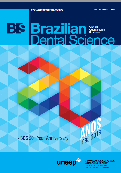Comparison of different final irrigant agitation techniques for the removal of Enterococcus faecalis biofilms from root canals: an in vitro study
DOI:
https://doi.org/10.14295/bds.2018.v21i4.1599Abstract
Objective: The aim of this in vitro study was to compare the effectiveness of different final irrigant agitation techniques in the removal of Enterococcus faecalis biofilms from root canals. Material and Methods: In total, the root canals of 85 extracted single-rooted human maxillary incisors teeth were prepared using the Revo-S system to a 40/06 size. The apical foramen of each tooth was sealed by light-cured resin composite material to obstruct bacterial leakage. The specimens were sterilized in an autoclave at 121°C for 15 min and stored until further use. All teeth except five (negative control group) were inoculated with Enterococcus faecalis and incubated in a CO2 chamber at 37°C for 7 days; the trypticase soy broth was changed every 2 days. For the determination of possible biofilm formation, five of the 80 teeth were randomly selected as a positive control group; one tooth of positive control group was analysed for biofilm development by scanning electron microscope (SEM) and these teeth received no final irrigant agitation procedure. Then, the remaining 75 teeth were randomly divided into five test groups (n=15 each) and were sequentially irrigated with 5% sodium hypochlorite (NaOCl), 17% ethylenediaminetetraacetic acid and 5% NaOCl. Following each irrigant application, different final irrigant agitation techniques were introduced for 60 s (3×20-s sessions). Group 1 received manual–dynamic agitation, group 2 received passive ultrasonic agitation (PUI), group 3 received EndoActivator agitation, group 4 received photon-initiated photoacoustic streaming (PIPS) with the Er:YAG laser and group 5 received conventional syringe irrigation. Colony-forming units (CFUs) were counted in samples from the positive control and test groups. Data were analysed using Kruskal–Wallis and post-hoc Mann–Whitney U multiple comparison tests. Results: E. faecalis elimination was significantly better in the experimental groups than in the positive control groups (p < 0.001). Manual–dynamic agitation and conventional syringe irrigation, with no significant differences between the two groups. Conclusion: Essentially, CFU reduction was significantly greater in the PUI, EndoActivator and PIPS groups than in the manual–dynamic agitation and conventional syringe irrigation groups (p <0.001), with no significant differences among the former three groups.
Keywords
Enterococcus faecalis; Irrigant agitation; Irrigant solutions; Photon-initiated photoacoustic streaming; Passive ultrasonic irrigation.
Downloads
Downloads
Published
How to Cite
Issue
Section
License
Brazilian Dental Science uses the Creative Commons (CC-BY 4.0) license, thus preserving the integrity of articles in an open access environment. The journal allows the author to retain publishing rights without restrictions.
=================




























